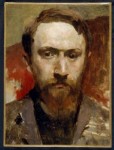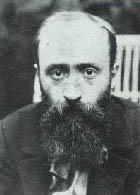
Edouard Vuillard
French, 1868-1940
La Partie de Dame (A Game of Checkers), 1905 ca.
oil on canvas
16 1/2 x 15 1/2 in.
SBMA, Gift of Robert and Mercedes Eichholz in celebration of the Museum’s 50th Anniversary
1991.46.2

Edouard Vuillard, Self Portrait, ca. 1890, Oil on canvas, 12 3/4 x 9 1/2 in., Indiana Museum Art Museum
"I don't make portraits, I paint people in their homes."
Edouard Vuillard
RESEARCH PAPER
Edouard Vuillard was born in the little town of Cuiseaux in the Saone-et-Loire, on November 11, 1868. The family moved to Paris I n 1877. In his early years he showed little interest in art. He was educated by the Marist Fathers and they were strict disciplinarians. He always thought he would go into the army as his father before him, and then into public service. He was not wayward or bohemian. He had a great gift of steadfast application and a sweet and gentle nature. Vuillard's father died in 1884. His mother was only 45 and fortunately in good health. She became a seamstress in her home and made corsets and managed to support her family.
Vuillard attended the Lycee Condorcet on a scholarship. It was one of the two or three best schools in Paris. Vuillard met his future brother-in-law, Ker-Xavier Roussel here, the son of a well-to-do doctor. It was Roussel who steered Vuillard in the direction of painting. In 1887 Vuillard went to day classes in Delacroix's old studio and evening classes at the Ecole des Gobelins, and in both places Diogene Maillart, winner of the Prie de Rome and hero of the Salons, was his teacher. He also studied at Academie Julian and Ecole des Beaux-Artes. In 1889 he succeeded for the first and last time in getting a Conte crayon drawing into the Salon.
Vuillard was one of the many very good French painters of the last 150 years who gave themselves the firmest possible grounding in the great tradition of French art. Vuillard was one of great self-portraitists. He did not begin to fulfill himself completely until he had fallen in with the people among his own contemporaries who had most to give him. He loved Le Suere, Chardin and Corot - but he loved them as seniors, and as people whose careers were a part of history. Where his own career was concerned, the decisive encounters were with people born within a few years of him. All of these encounters had taken place by the time of his 21st birthday in November 1889.
In 1890 Vuillard was renting a studio with Pierre Bonnard and they became very good friends. The studio became a meeting place for a group of artists, actors and writers (Gaugin often visited), who loved to gather there and discuss art and philosophy. In 1900 Vuillard used a more naturalistic style. He and Bonnard were among the first to use the Intimae style.
"La Partie de Dames" 1905
Vuillard was a gifted colorist. In his "La Partie de Dames" the human beings are like still life pieces. Even though the people are grouped, they seem to disappear - you see walls, windows, furniture and curtains. Most of his subjects were close friends and family. Vuillard painted small, quiet pictures of women (12" by 18" is fairly large for him). The figures in Vuillard's painting have an ethereal quality. There isn't any emotion evident in the figures, yet they portray a group of people in the painting the artist has brought together. The painting is muted with loosely applied color. In Vuillard, people and patterns combine to make something more than themselves; he does not paint things so much as moods.
Vuillard belonged to an artistic fraternity known as the Nabis, a name coined by the poet Cazalis from a Hebrew word meaning "prophet", and was dedicated to such credos as appearance should not be reproduced in a literal manner and color can and should be used in a decorative and arbitrary way. After a few years and several exhibitions, the Nabis gradually disbanded. The Nabi theory left an imprint on Vuillard's style. He was also influenced by the painting of Redon, the late work of Degas and by the Japanese print. From this background Vuillard acquired his own highly original style.
The overall pattern of the composition creates a subdued group of people without obvious interaction. Adhering to the Nabi dictum in the importance of background to the general design, everyone blends into the painting. The low-keyed colors and short brush strokes are muted and the viewer sees, not one object, but a whole scene at one time, with linear positions in the background, which also attract your attention.
Vuillard lived with his Mother in Paris until her death in 1928 when he was 60 years old. The love of his life was a glamorous Polish pianist named Misia Natanson. Since the object of his devotion was a Polish pianist, the paintings also seem musical (Chopin, of course) in their patterning and are steeped in the gorgeous, but rather romantic melancholy of the nineteenth century. Vuillard died in 1940. He never married.
Prepared for the Santa Barbara Museum of Art Docent Council by Lanel Kally, May 1994.
Website Preparer, Nyna Mahan
POSTSCRIPT
One of the main figures in this painting was once identified in an older title, The Game of Checkers (Tristan Bernard at Madame Aron’s House), ca. 1905. However, two female figures and a secondary man create the grouping. Even with a close examination of the men playing checkers, it is difficult to tell which one is Mr. Bernard. The main and central figure in this painting has many of the same features as the artist himself. Vuillard is famously known for painting self-portraits, and with this knowledge, it raises the question of "Who is in this painting"? (see quote above)
posted by Loree Gold 2012

Undated photo of Vuillard.
SBMA CURATORIAL LABELS
In a bourgeois interior, rendered in a muted palette of browns, grays and cream, Vuillard depicts his friend, the playwright Tristan Bernard, playing checkers with an opponent whose figure is cropped by the edge of the canvas. This was one of Vuillard’s favorite techniques, informed by his interest in photography. The women in the background are Bernard’s future wife Marcelle Aron and her cousin Lucy Hessel, Vuillard’s lover and the wife of his dealer Jos Hessel. The inclusion of lighter tones is typical of Vuillard’s work from this period, when the claustrophobic interiors that had previously dominated his oeuvre gradually gave way to less emotionally fraught scenes inspired by the rural holidays he spent with the Hessels.
- Ridley-Tree Reinstallation, 2022
